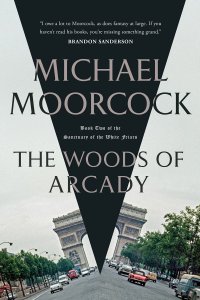Ian Mond Reviews The Heap by Sean Adams
 The Heap, Sean Adams (Morrow 978-0-062-95773-3, $26.99, 320pp, hc) January 2020.
The Heap, Sean Adams (Morrow 978-0-062-95773-3, $26.99, 320pp, hc) January 2020.
Sean Adams’s debut, The Heap, tells the story of the literal rise and fall of Los Verticalés (“the Vert”), an architecturally unsound high-rise, nearly five hundred storeys tall, that “grew up rather than out… bustling with life and excitement,” until one day it came crashing down, covering the desert with acres and acres of “mountainous remains.” While the initial relief effort finds no survivors, ten days after the collapse the radio-waves pick up Bernard Anders, a resident and disc jockey known as the “Voice of the Vert.” With a confirmed survivor – especially one happy to discuss his experience of being buried under miles and miles of debris – the Vert’s developer, the obscenely wealthy Peter Thisbee, recognises an opportunity to turn the disaster in his favour. He establishes the Los Verticalés Relief Foundation, which not only provides volunteers with a “fully weatherized camper, a rehabilitated bicycle and a small living stipend,” but high-tech gear, such as “ConductionSens” shovels that alert a person to an electrical current before they start digging. His plan works. Hundreds of people are lured to the Vert, taking residence in CamperTown, the small community that sits alongside the Dig Site. This includes Oliver Anders, Bernard’s brother, who, with his digging partners Lydia and Hans, shovels through the wreckage. During the evening, Oliver rings through to his brother’s show, where Bernard shares memories about their childhood. Then, one day, Oliver is approached by Hal Cornish from Sundial Media, the company that boosts Bernard’s signal across the country. He explains to Oliver that the two brothers have become celebrities, their intimate conversations heard by millions, even as far as Chile. They’ve become so popular that there are “advertisers hungry for a piece of this pie,” who are more than willing to sponsor a new segment called “Brother Talk,” provided Oliver slips in a mention about the sponsor’s products. Taken aback by this commodification of Bernard’s suffering, Oliver refuses to take part. Next thing he knows the phone banks have been shut down, and someone who sounds just like Oliver is reminiscing about the past with Bernard, punctuating the conversation with product placements.
While it’s never made clear, the setting of The Heap reads like a version of present-day America where advancements in technology stalled around the 1940s. Everyone still uses conventional phones, analogue radio is a going concern, and there’s no mention of computers, the internet, social media, or mobile phones. The technology that is present, such as the ConductionSens shovel, wouldn’t be out of place in The Jetsons. Added to this pulpish aesthetic is a zany sense of humour, exemplified by the Vocalist Cartel, a syndicate of “voice actors without morals [who are] willing to do anything for a price.” It’s a brilliant idea that’s both Pythonesque in its conception, but also genuinely sinister, as Oliver discovers to his detriment.
As much as I enjoyed the Cartel, what I truly loved was how Adams, across the course of the novel, parcelled out the extraordinary story of Los Verticalés. Every two or three chapters, we get excerpts from a book – “From the Later Years” – written by surviving residents, which details life inside the high-rise. The first thing we’re told is that the Vert, like everywhere else, is separated by class. The “haves” live in outer units with windows looking out onto the desert, while the “have-nots” reside in the inner condos, their apartments fitted with “UV screens that streamed a view of the outside world and could ‘recreate 92 percent of the window experience.”‘ Despite the social stratification, there’s a strong sense of community – a central theme of the novel – where each “floor worked like a neighbourhood, the stairwell and the elevator serving respectively as the highway and the high-speed rail, connecting distinct urban districts.” Just like Peter Thisbee built the Vert level by level, Adams adds a layer of worldbuilding with each excerpt – whether it’s an explanation of the Vert’s political structure or the establishment of a bordello in the underground carpark – that deepens our understanding of this strange, fascinating enclosed world. Behind it all, though, is the tragic foreknowledge that for all the eccentricities, for all the customs and traditions and improvised solutions that come from living in an almost hermetically sealed environment, things won’t last – the building will fall.
The Heap is a deeply weird but poignant novel about the extended family we discover amongst the rubble and ruin of a rich man’s folly.
Ian Mond loves to talk about books. For eight years he co-hosted a book podcast, The Writer and the Critic, with Kirstyn McDermott. Recently he has revived his blog, The Hysterical Hamster, and is again posting mostly vulgar reviews on an eclectic range of literary and genre novels. You can also follow Ian on Twitter (@Mondyboy) or contact him at mondyboy74@gmail.com.
This review and more like it in the January 2020 issue of Locus.
 While you are here, please take a moment to support Locus with a one-time or recurring donation. We rely on reader donations to keep the magazine and site going, and would like to keep the site paywall free, but WE NEED YOUR FINANCIAL SUPPORT to continue quality coverage of the science fiction and fantasy field.
While you are here, please take a moment to support Locus with a one-time or recurring donation. We rely on reader donations to keep the magazine and site going, and would like to keep the site paywall free, but WE NEED YOUR FINANCIAL SUPPORT to continue quality coverage of the science fiction and fantasy field.






